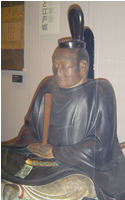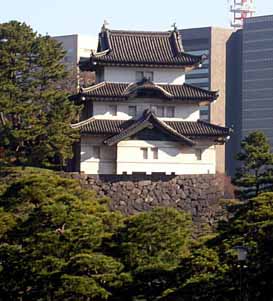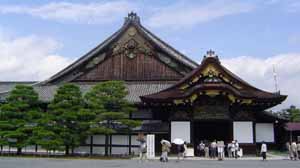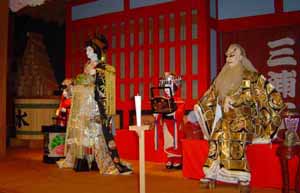Edo Period1603-1868 |
|
||||||||||||||||||||||||||||||||||||||||||||||||||||||||||||||||||||||||||||||||||||||||||||||||||
 After
Toyotomi Hideyoshi died in 1598, Tokugawa Ieyasu (at left) as left as the
most powerful man in Japan. In 1600, Ieyasu defeated his rivals in the Battle
of Sekigahara and secured himself in control of Eastern Honshu. By 1603, he
was named shogun and established his
government in Edo (present day Tokyo). He began a dynasty of shoguns
from the Tokugawa family that lasted 250 years.One of the ways he tried to
control other prominent Japanese was by ordering all the regional lords to
destroy any castle they had except the one they lived in. They were also strongly
encouraged to learn more than military matters. Although he retired as shogun
in 1605 in favor of his son, Hidetada, Hideyoshi continued to serve Japan
in other ways. He oversaw the expansion of what would become Edo Castle and
the surrounding area (modern day Tokyo) and worked on diplomatic business
with the Dutch and Spanish. He also composed the Kuge Shohatto in 1613. This
placed limitations on the nobility which were then added to in 1614 and amended
in 1635. Later, he issued the Christian Expulsion Edict in 1614. In 1616,
one year after defeating Toyotomi Hideyor, Toyotomi Hideyoshi's son, who had
challenged his family's role, he died.
After
Toyotomi Hideyoshi died in 1598, Tokugawa Ieyasu (at left) as left as the
most powerful man in Japan. In 1600, Ieyasu defeated his rivals in the Battle
of Sekigahara and secured himself in control of Eastern Honshu. By 1603, he
was named shogun and established his
government in Edo (present day Tokyo). He began a dynasty of shoguns
from the Tokugawa family that lasted 250 years.One of the ways he tried to
control other prominent Japanese was by ordering all the regional lords to
destroy any castle they had except the one they lived in. They were also strongly
encouraged to learn more than military matters. Although he retired as shogun
in 1605 in favor of his son, Hidetada, Hideyoshi continued to serve Japan
in other ways. He oversaw the expansion of what would become Edo Castle and
the surrounding area (modern day Tokyo) and worked on diplomatic business
with the Dutch and Spanish. He also composed the Kuge Shohatto in 1613. This
placed limitations on the nobility which were then added to in 1614 and amended
in 1635. Later, he issued the Christian Expulsion Edict in 1614. In 1616,
one year after defeating Toyotomi Hideyor, Toyotomi Hideyoshi's son, who had
challenged his family's role, he died.
 Edo
Castle was the place chosen by Tokugawa Ieyasu to become
the center of his control. What remains of the castle is pictured at right.
Edo Castle is also called Chiyoda Castle. It was build in 1457 by Ota Dokan
for the Uesugi clan but did not truly develop until 1590 when Tokugawa Ieyasu
settled the region. As the Tokugawa power grew so did Edo Castle and the surrounding
city. It became the largest castle in the world. Unfortunately, the original
castle was destroyed on January 18 and 19, 1657 when a large fired swept through
the city. The Meireki fire destroyed the castle as well as large portions
of the city. Through the discovery of plans,
Edo-Tokyo Museum has reconstructed a model of what the castle would look like.
Edo
Castle was the place chosen by Tokugawa Ieyasu to become
the center of his control. What remains of the castle is pictured at right.
Edo Castle is also called Chiyoda Castle. It was build in 1457 by Ota Dokan
for the Uesugi clan but did not truly develop until 1590 when Tokugawa Ieyasu
settled the region. As the Tokugawa power grew so did Edo Castle and the surrounding
city. It became the largest castle in the world. Unfortunately, the original
castle was destroyed on January 18 and 19, 1657 when a large fired swept through
the city. The Meireki fire destroyed the castle as well as large portions
of the city. Through the discovery of plans,
Edo-Tokyo Museum has reconstructed a model of what the castle would look like.
The castle had
a large chamber where daimyo were granted
meetings with the shogun, smaller chambers
where messengers were met, and side chambers
where business could be conducted. One building on the property of Edo castle
was an upper residence built by Matsudira
Iyo-no-kami Tadamasa. This too was destroyed in the Great Meireki fire. While
most of the buildings were not rebuilt, the traditional moats and walls that
surround a castle are still there. Beginning with the Great Meireki Fire in
1657, the castle went through a series of destructive fires in 1844 and 1860
followed by periods of rebuilding in 1659, 1845, and 1861. In 1868, the castle
was turned over to Emperor Meiji. This signified the end of the Edo Period
and the beginning of the Meiji Restoration. The emperor resided in Edo Castle
until a new Imperial Palace could be built. Edo Castle was destroyed yet again
during the bombing of Tokyo in World War II. Most of the grounds of Edo Castle
are now part of the Imperial Palace, but a small portion is open still to
the public.
Edo began as a small fishing village. Once the Tokugawa
Ieyasu established the city as his center of government, the city grew. The
new shogun's city was one of trade. When laying out the city, trade by boat
became a central part. To connect the city, a massive bridge called Nihonbashi
was constructed in 1603. While the original Nihonbashi no longer stands, it
has been replicated to scale in the Edo Museum. Click
here to see photos and descriptions of the bridge. The city itself was
laid out with row houses. The typical
house was only 3 meters (about 10 feet) by 4 meters (about 12 feet). This
allowed very little space. An entire family
would live in this area very compactly. While this allowed large numbers of
people to live together in small spaces, it was a fire hazard. The Great Meireki
Fire and later fires would cause the city planners to take measures to make
the city fire proof. One way this is done is by creating firebreaks between
groups of structures. This prevents the fire from spreading from one section
of the city to another. A second method is the development of a fire department.
In 1718, the first fire departments were established in Edo. There were 47
units each named after a kana character. Each section of the city had a tower
to watch for fire. They fire brigades would use a water
soaked staff with dangling material to spread water on fires. Like many
large cities, Edo had to provide its residents with water. The Kanda
Waterworks brought water from ponds and dammed rivers to Edo.
 Nojo
Castle was built by Tokugawa Ieyasu for the residence of the Tokugawa shoguns
in Kyoto. Because Kyoto was still the capital of Japan, a road from Edo to
Kyoto was maintained. Nojo Castle was used by the shoguns when their business
would take them to Kyoto. In 1569, Oda Nobunaga began construction of a mansion
on the site. Nobunaga's early demise left the property for development. In
1603, Tokugawa Ieyasu built Nojo as his head quarters in Kyoto. Among the
important historical events that took place at the castle are peace talks
between Tokugawa Ieyasu and Toyotomi Hideyori and the declaration that Shogun
Tokugawa Yoshinobu would return his power to the emperor in 1867. The castle
itself does not have the magnitude of protection that other earlier built
castles. It was constructed in a time of relative peace. There is an outer
wall and moat complete with a tower and
guardhouse inside the gate. Inside the
outer wall is the Chinese Gate. This
leads you into Ninomaru Palace. This palace
is the typical warrior's home and would not house the shogun's living quarters.
Instead samurai would live in the rooms where officials were received. The
floors of the palace are nightingale floors.
The floors are constructed in such a way that as you walk, noise similar to
a nightingale is given off. The sleeping samurai
would then be alerted to any intruder. The interior of Ninomaru Palace cannot
be photographed but are covered with sliding screens that are decorated with
pines. Just beyond this structure are gardens. In the traditional Japanese
style, there is a waterfall and
pond. Within the grounds there is another set
of gates leading to a higher section of land. This section of land has
its own wall and moat.
This is where Nojo's donjon was built.
The view from the site shows the military
advantage the site gives. The donjon
was struck by lighting in 1750 and burned to the ground. It was never rebuilt.
Also on this section of land is Honmaru
Palace. This building was moved there after the donjon
burned down.
Nojo
Castle was built by Tokugawa Ieyasu for the residence of the Tokugawa shoguns
in Kyoto. Because Kyoto was still the capital of Japan, a road from Edo to
Kyoto was maintained. Nojo Castle was used by the shoguns when their business
would take them to Kyoto. In 1569, Oda Nobunaga began construction of a mansion
on the site. Nobunaga's early demise left the property for development. In
1603, Tokugawa Ieyasu built Nojo as his head quarters in Kyoto. Among the
important historical events that took place at the castle are peace talks
between Tokugawa Ieyasu and Toyotomi Hideyori and the declaration that Shogun
Tokugawa Yoshinobu would return his power to the emperor in 1867. The castle
itself does not have the magnitude of protection that other earlier built
castles. It was constructed in a time of relative peace. There is an outer
wall and moat complete with a tower and
guardhouse inside the gate. Inside the
outer wall is the Chinese Gate. This
leads you into Ninomaru Palace. This palace
is the typical warrior's home and would not house the shogun's living quarters.
Instead samurai would live in the rooms where officials were received. The
floors of the palace are nightingale floors.
The floors are constructed in such a way that as you walk, noise similar to
a nightingale is given off. The sleeping samurai
would then be alerted to any intruder. The interior of Ninomaru Palace cannot
be photographed but are covered with sliding screens that are decorated with
pines. Just beyond this structure are gardens. In the traditional Japanese
style, there is a waterfall and
pond. Within the grounds there is another set
of gates leading to a higher section of land. This section of land has
its own wall and moat.
This is where Nojo's donjon was built.
The view from the site shows the military
advantage the site gives. The donjon
was struck by lighting in 1750 and burned to the ground. It was never rebuilt.
Also on this section of land is Honmaru
Palace. This building was moved there after the donjon
burned down.
Government policies during the Edo period favored isolationism and structure. In 1633, Shogun Tokugawa Iemitsu ended foreign travel and in 1639 limited Japanese trade partners to China and Netherlands and only from Nagasaki. The Europeans including the Russians wanted to establish trade with Japan by the end the 1700's. This isolation did not come to an end until the end of the Edo period. In 1853 and 1854, The American Commodore Matthew Perry forced the government to open a limited number of ports, including Edo for international trade. The Meiji Restoration in 1868, brought an end to the isolation of Japan. Along with foreign trade, foreign books were banned. The government stressed the importance of morals, education and class society. A four class system existed placing samurai on top followed by peasants, artisans and merchants. A filth class made up of people who held unacceptable professions was at the bottom.
During the Edo period, many works of literature were written. This was in part to the increase in literacy and prosperity. More people could read and had the money to spend on books. Consequently, a large book printing industry developed. Several shops opened in the area now known as Minato in Tokyo. The shops would sell novelettes, scholarly books, maps, textbooks and woodcut prints. In 1682, The Life of an Amorous Man (Koshoku ichidai otoko) by Ihara Saikaku was published and received commercial success. Perhaps the most famous literary export during this time period was haiku This is a light verse centered around nature and the lives of ordinary people. The most famous haiku poet was Matshu Basho. He wrote many travel diaries like the 1694 Oku no hosomici ( the Narrow Road to the Deep North) . Perhaps one of the most lasting pieces of literature that came out of this time period is The Book of Five Rings (Go Rin No Sho) by Miyamoto Musashi. Written in 1645, it details the way of training for the samurai. Musashi lived as ronin in Japan during the late Azuchi-Momoyama Period and the early Edo Period. He witnessed his country go from chaos to unity under three powerful shogun. It includes advice that he was able to make transcend time. The Book of Five Rings is still read by businessmen in Japan to help learn strategy. Although there were a large number of works of literature produced during this time period, there was heavy censorship. The censorship began against Christian books, but expanded in 1722, 1780's and the 1840's. Overtime specific authors and satires were censored.
 Drama
also enjoyed success during the Edo Period. Playhouses were established and
held puppet plays (joruiri) and of course kabuki. The plots of Kabuki plays
would often focused on the social class system developed by the Tokugawa shogun
ate. Kabuki developed over time and the need for the merchant class to have
entertainment. The upper class had supported the Noh Theater and the merchant
class wanted something of their own to support. Eventually kabuki attracted
members of all classes. The characters that make up kabuki means dance, music,
and craft. Kabuki is credited to a shrine dancer named Okuni who began performances
in Kyoto in 1603. While kabuki was founded by a female, women performing were
forbidden by the Tokugawa shognate in the later Edo Period. The traditional
kabuki stage rotates and has many
trap doors that allow people to move in and out of stage. The
actors wear elaborate costumes
and often men would play the role of women.
Kabuki theaters needed to be large structures
that held large audiences as well as props.
Drama
also enjoyed success during the Edo Period. Playhouses were established and
held puppet plays (joruiri) and of course kabuki. The plots of Kabuki plays
would often focused on the social class system developed by the Tokugawa shogun
ate. Kabuki developed over time and the need for the merchant class to have
entertainment. The upper class had supported the Noh Theater and the merchant
class wanted something of their own to support. Eventually kabuki attracted
members of all classes. The characters that make up kabuki means dance, music,
and craft. Kabuki is credited to a shrine dancer named Okuni who began performances
in Kyoto in 1603. While kabuki was founded by a female, women performing were
forbidden by the Tokugawa shognate in the later Edo Period. The traditional
kabuki stage rotates and has many
trap doors that allow people to move in and out of stage. The
actors wear elaborate costumes
and often men would play the role of women.
Kabuki theaters needed to be large structures
that held large audiences as well as props.
 One
of the more popular subjects of the kabuki is the story of the 47 Ronin.
The story of the 47 ronin begins with a fight between two lords, Lord Kira
Hozukenosuke and Asano Takuminokami. In March 1701, after repeatedly being
provoked, lord Asano Takuminokami attacked Kira Hozukenosuke but failed to
kill him. Asano was ordered to commit seppuku
but Kira was not punished. Asano's punishment was beyond death. He and
his family were removed from power leaving his samurai
without a lord to command them. These forty-seven men felt the need to avenge
his unfair punishment. On December 14, 1702, eighteen months of planning came
into action. Under the leadership of Oishi Kuranosuke, the group went to Kita's
mansion and killed him. They severed his head and took it to Sengakuji where
their lord was buried. Later they were ordered to commit seppuku.
They are buried (above at left) at Sengakuji with their lord. Click
here to see a guide on Buddhist Temples.
One
of the more popular subjects of the kabuki is the story of the 47 Ronin.
The story of the 47 ronin begins with a fight between two lords, Lord Kira
Hozukenosuke and Asano Takuminokami. In March 1701, after repeatedly being
provoked, lord Asano Takuminokami attacked Kira Hozukenosuke but failed to
kill him. Asano was ordered to commit seppuku
but Kira was not punished. Asano's punishment was beyond death. He and
his family were removed from power leaving his samurai
without a lord to command them. These forty-seven men felt the need to avenge
his unfair punishment. On December 14, 1702, eighteen months of planning came
into action. Under the leadership of Oishi Kuranosuke, the group went to Kita's
mansion and killed him. They severed his head and took it to Sengakuji where
their lord was buried. Later they were ordered to commit seppuku.
They are buried (above at left) at Sengakuji with their lord. Click
here to see a guide on Buddhist Temples.
As more people became unhappy with the censorship, isolation, and rigid social structure of the Tokugawa shogunate, a call to return to imperial power began. Even conservative members of the samurai class saw the need for trade with western nations. After political pressure, the Tokugawa government fell and the power of Emperor Meiji was restored.On November 9, 1867 at Nojo Castle, Shogun Tokugawa Yoshinobu ended the Tokugawa Shogunate by resigning as the 15th Tokugawa Shogun. The power of the Emperor Meiji was solidified by the Five Charter Oath in 1868. This ended 1,000 years of a dual government structure in Japan. The Meiji Restoration with its westernization policy. signified the beginning of modern Japan.
to return to Mrs. O'Donnell's Home Page.
Maintained according to the Lakeland
Central School District Web Page Policies and Guidelines.
Clicking
on the above links will direct you to site(s) outside the Lakeland Central
School District and the Lakeland High School server. The Lakeland Central
School District is not responsible for contents on external sites and servers,
nor does the district endorse the sponsors or advertising on these sites.”
This site was designed and maintained by Maureen
O'Donnell, a teacher at Lakeland
High School.
July 2005 Created - |
Saturday, February 25, 2006
Last Revised -













